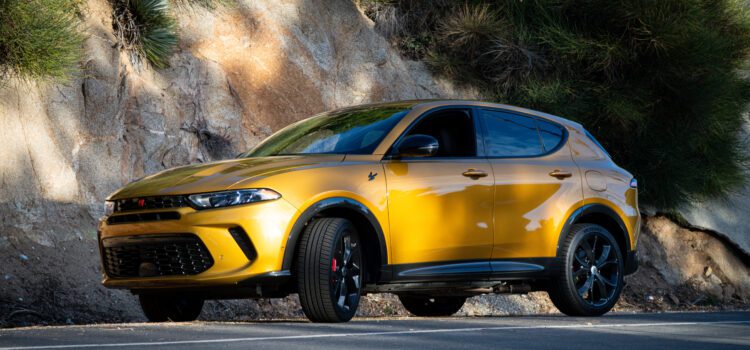The Dodge Hornet R/T is America’s little Italian hybrid hot hatch for better and worse
I never go into the world of crossovers expecting much in the way of creativity or differentiation. Small family crossovers are all mostly drawn from the same cookie-cutter template. But that’s also to say they all do their job commendably well. They’re all roomy. They’re all reasonably fuel-efficient. They’re all easy to drive, easy to live with, and easy to use for all your family, commuting, or household needs. They’re fine cars, and if you throw a dart at anything on the board, you’ll probably land on something you’ll enjoy. Maybe not as a driving enthusiast, obviously. But it’ll serve its purpose well. And that’s why I’m so excited to sample an oddity like the Dodge Hornet R/T.
Where have you been the whole time, you shifty little rat?
In a sea of dull but glaringly obvious choices in the market, here comes the Hornet R/T (and, by extension, the Alfa Romeo Tonale) to rule its only little corner of the kingdom and do it its own way. In R/T guise, it can be had with a spunky plug-in hybrid akin to the RAV4 Prime. Except, unlike that longtime favorite, this diminutive crossover has… wait, Brembo brakes? Wait, dual-valve Koni shocks? Michelin Pilot Sport All Season 4 tires? Metal paddle shifters? Hold up. Something’s special about this gold jellybean on stilts, and I’m going to get to the bottom of this.
Skip to section:
- Specs
- Design
- Price
- Interior and tech
- A different kind of commuter
- A different kind of hot hatch
- Conclusion

🚦Get ready, set, full disclosure! Some of the links powering our posts contain affiliate links, which means we may earn a small commission if you decide to make a purchase, even if it’s not from the page we linked. Affiliate links are not always an endorsement of the product. To really help us keep our headlights shining to make more content like this, subscribe to the Acceleramota newsletter.
Price and specs
GTI and GR86 fans, read it and weep. The Hornet R/T is indeed a threat. 288 horsepower and a sports car-rivaling 383 pound-feet place it squarely within the realm of entry and mid-level performance cars, and the big kid magazines’ test teams have the test numbers to prove it. Thank the 1.3-liter turbo four-banger assisted by a plug-in hybrid system consisting of two AC motors (one more than Tonale, likely resulting in its higher torque figure) and a 15.5-kWh battery, with the latter half of the powertrain being capable of up to 32 miles of EV-only commuting up to 84 mph. However, that impressive spec sheet comes at a wince-inducing price tag for our tester, which stickers at a hefty $52,405.
[Button id=”417″]
| Base price: | $41,400 |
| As-tested price: | $52,405 |
| Engine: | 1.3-liter turbocharged I4 + 2 AC motors, 15.5-kWh lithium-ion battery |
| Transmission: | 6-speed automatic |
| Drivetrain: | All-wheel drive |
| Power: | 288 horsepower |
| Torque: | 383 pound-feet |
| Redline: | 7,000 rpm |
| Weight: | 4,200 pounds |
| Zero-to-60 mph: | 5.5 seconds |
| ¼-mile: | 14.2 seconds @ 96 mph |
| MPG: | 29 combined |
| MPGe: | 77 combined |
| Observed MPG: | 29.2 MPG |
| EV Range: | 32 miles |
| Fuel Capacity: | 11.2 gallons |
Hornet R/T exterior design
Oh, thank the car gods that Italy had the heaviest influence in designing this vehicle. Yes, this is still very much an Alfa Romeo Tonale underneath, from the shape to the glass and the rear fascia. The starkest change is really just that Dodge Charger-fied mug, which itself looks pretty damn decent, and the headlights are still very much Tonale, albeit with a different lighting pattern inside the lens.

If you care not for family crossovers, then perhaps you’ll find nothing remarkable here. But one must admit it’s a refreshingly smooth and elegant way to do a RAV4 rival, with hardly any sharp creases aside from the questionably functional hood vents and Dodge grille. The smooth, paper-thin light bar streaking across the rear hatch is a fun Euro touch, as are the dual-exit exhausts that protrude through the bumper rather than beneath it. Oh, and there’s no denying how gorgeous Acapulco Gold is, and I don’t even like yellows on cars.
Cough, Tonale still looks better. Just by a bit.
Perhaps what is most enjoyable is that it’s not a diminutive two-row crossover pretending to be something sportier, bigger, or more “off-roady” than it really is from the outside. It looks small. It’s styled small. It is small. It’s honest without being drab, which should be enough to lure at least a few prospective car buyers away from Toyota or Honda lots.

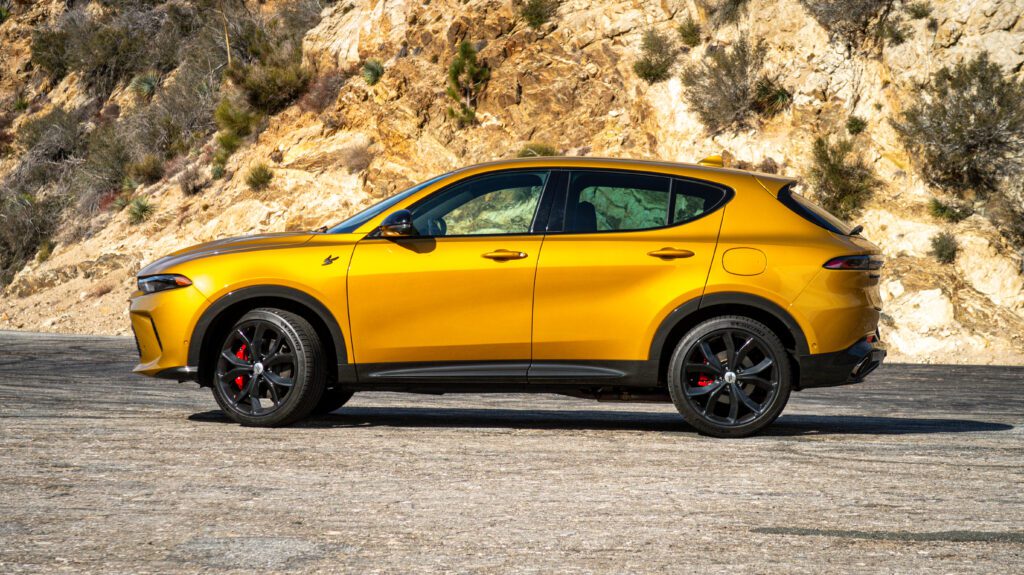
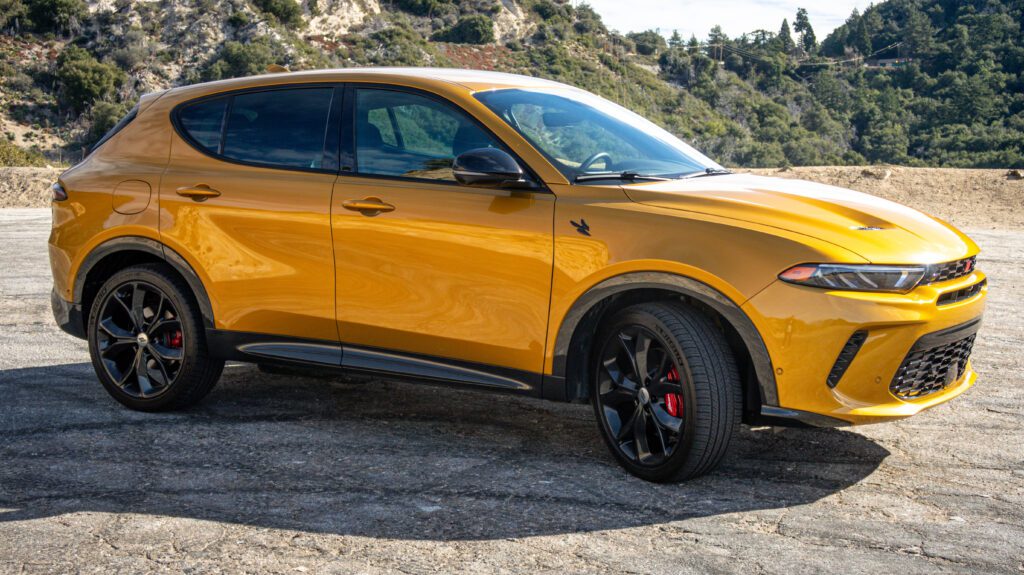
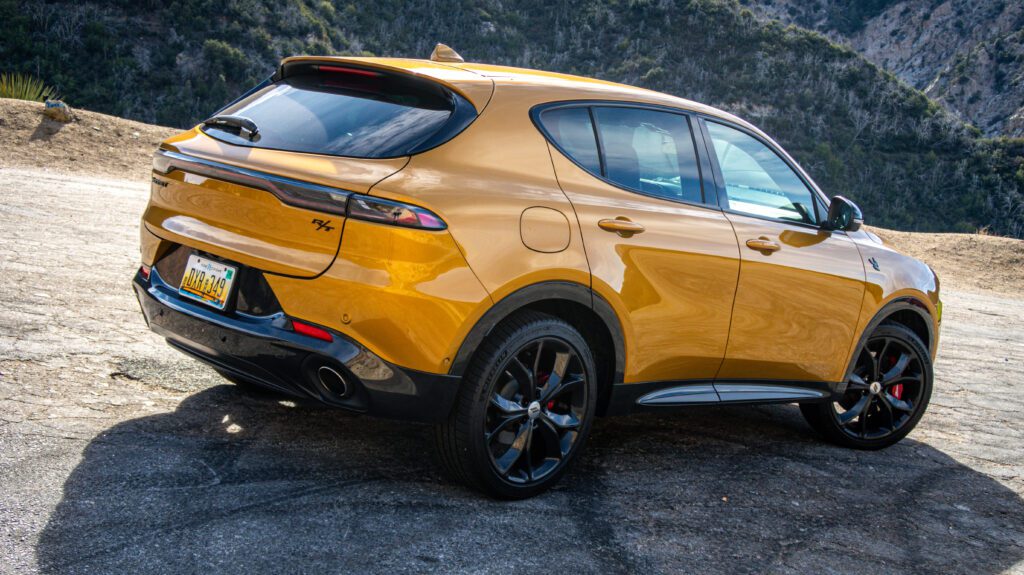
| What’s hot? | – Intoxicating power for a family crossover – Nimble, responsive chassis – “Just right” damper tuning with many talents – “Just right” size for urban excursions – Useful EV range with commendable regen abilities – Italian styling |
Hornet R/T pricing breakdown
Before we dive into our specific tester, do note that you can get lower-rung GTs for a starting price of $31,400. Not bad! GT and more tech and luxury-laden GT Plus trims feature a Dodge-exclusive, all-ICE, non-hybrid 2.0-liter turbo powertrain not currently offered on U.S. Alfa Tonales. For a notable ten-grand discount off an optionless R/T, you score a comparable 268 horsepower and 295 pound-feet, with performance figures that are barely slower. Hmm, interesting. However, no paddle shifters are available for that powertrain’s 9-speed auto, and there are obviously no hybrid drive modes or EV-only capability.
Our R/T Plus starts at $46,400 and adds a sizeable moonroof, Harmon Kardon audio system, heated and ventilated power seats, and power liftgate. Acapulco Gold adds $595, although other colors can be had for $495 or free. The $2,345 Tech Package adds surround-view cameras, front, rear, and side parking assist, and Level 2 autonomy with adaptive cruise and lane centering. Lofty, sure. Worth it? We’ll discuss it momentarily. But get this.


What gimmicky bundle of ironic coolness has me rolling my eyes to the back of my skull while also screaming “HELL YEAH” is the availability of the (drum roll) Track Package. Track. Package. You can spec your hybrid family compact crossover with a $2,595 track pack. Although this pack features a severe lack of oil coolers, stupid wings, or carbon ceramic brakes, you do get 20-inch wheels wrapped in Michelin Pilot Sport All Season 4 tires, red-painted four-piston Brembos, and adaptive twin-valve KONI shocks.
I iterate once more: Hell yeah.

Hornet R/T interior and tech
Inside is a standard Stellantis affair with a unique Italian flair, resulting in a cabin that’s practical and comfortable without being a boring hodgepodge of flat surfaces. The center console and transmission tunnel gradually rise to meet the climate controls on the dashboard, leaving an angled surface for your wireless charger. And the center console storage bin provides ample space for wallets, phones, garage clickers, or maybe four or five small hot dogs. Maybe.

Rear passenger space is ample, with a fold-down center armrest with cupholders and a rear cargo area passthrough, which may come in handy from time to time, as the rear cargo area doesn’t appear any more spacious than a large hatchback. With 22.9 cubic feet of cargo volume, it’s roughly on par with a Kia Niro but down on a RAV4 or Ford Escape by several cubic feet. At least rear-seat passengers get their own climate vents plus USB charging, but I suppose that’s expected in this era and at that lofty price point.
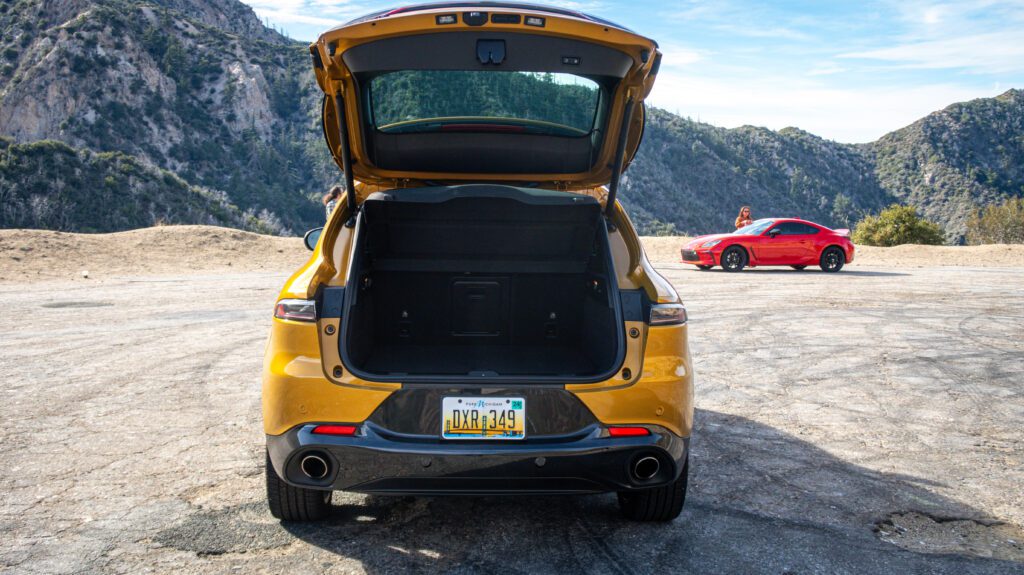
The aforementioned Tech Package means our Hornet tester is graced with Level 2 autonomy in the form of lane centering and adaptive cruise. Surround-view cameras bunched with front and rear parking sensors and blind spot monitoring mean the Hornet should (theoretically) be uncrashable. Or so you’d hope. If any of these doo-dads bug you for whatever reason, they’re defeatable via hard buttons or through settings in the 10.25-inch uConnect touchscreen. The latter also houses wired and wireless CarPlay and Android Auto, built-in nav (hallelujah!), and readouts for performance gauges, electric charge, and more. The standard digital gauge cluster can also display accompanying readouts for fuel economy and which half of the powertrain, gas or electric, is using how much energy.
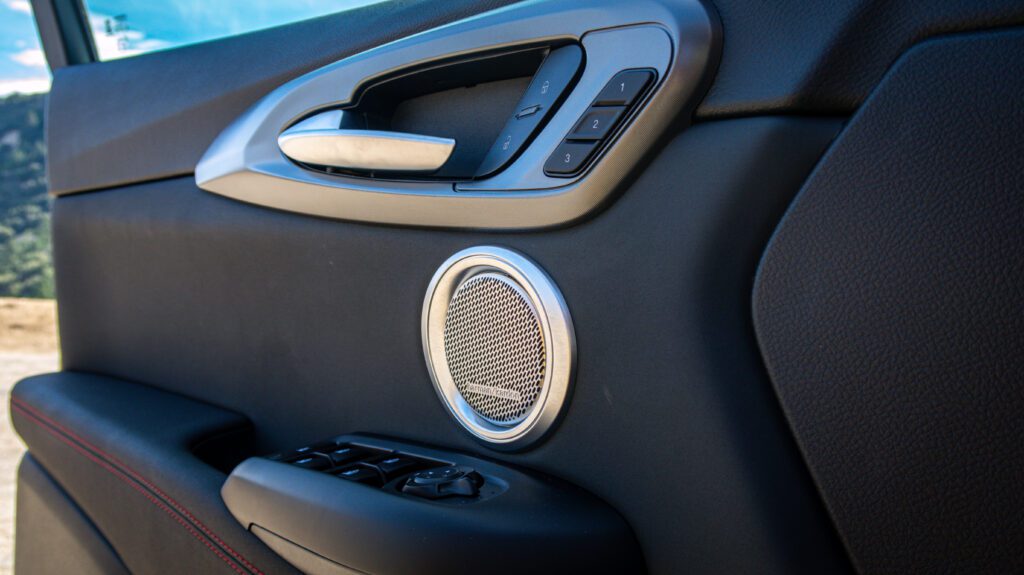



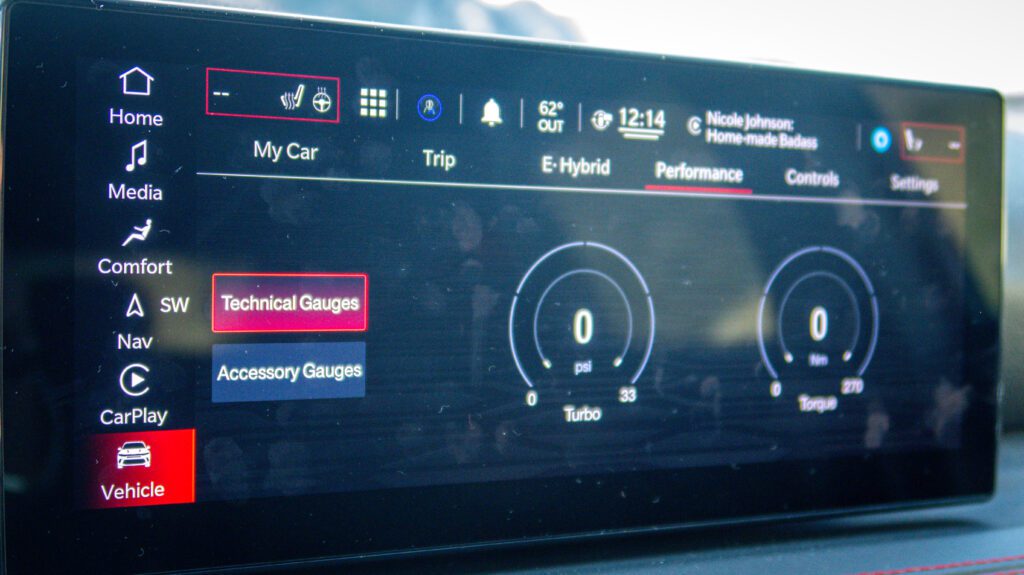
A different kind of commuter car
Fascinating. This two-row family crossover excels as a two-row family crossover. I never would’ve guessed.
Slap it in Hybrid or Electric via the drive mode button on the wheel, and let the Hornet R/T deliver you from your typical bland commuter car woes. The perforated suede seats are cozy. The heated steering wheel is toasty and fits beautifully in your hands. The uConnect touchscreen is fast, responsive, and immediately easy to learn in a matter of minutes. A vertical stack of shortcut buttons keeps CarPlay, music, or nav functions at a finger’s touch at all times.
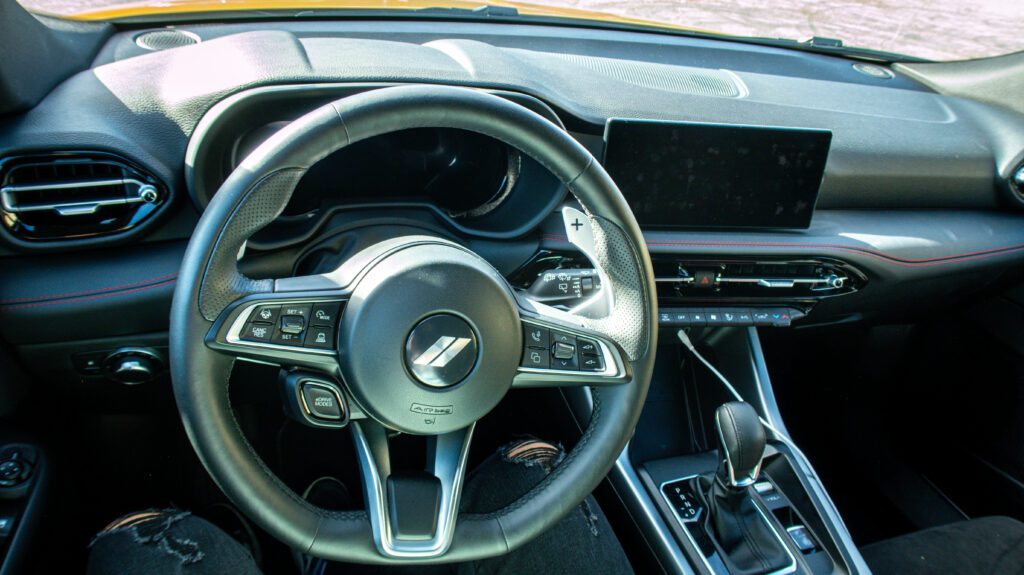
Out on the open road, the Hornet is fairly quiet and comfortable. In fact, I’d argue it exceeds expectations for something with such a small stature and short wheelbase. Props to the Track Pack’s KONI dampers for excellently dispatching most of what Cali roads have to throw at it. Speed bumps, expansion joints, point holes? Pfft. The Hornet moseys on over all of them with little harshness sent through the cabin, only occasionally wallowing over large undulations as one would expect from a smaller car, like a tiny vessel over a large wave. But even over the largest lumps, it’s as composed and settled as can be. And to think its Tonale twin is even more refined, according to a little birdie who helped engineer it.
Don’t let the cutesy silhouette fool you into thinking it’s a cheap tinker toy. The Hornet is a genuinely well-mannered city car with an affinity for navigating the concrete jungle.
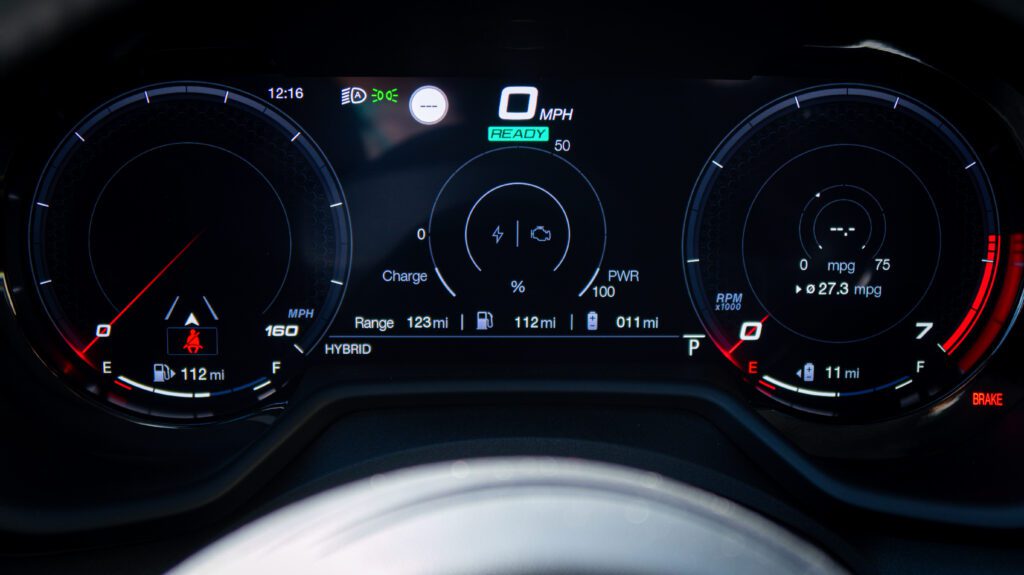
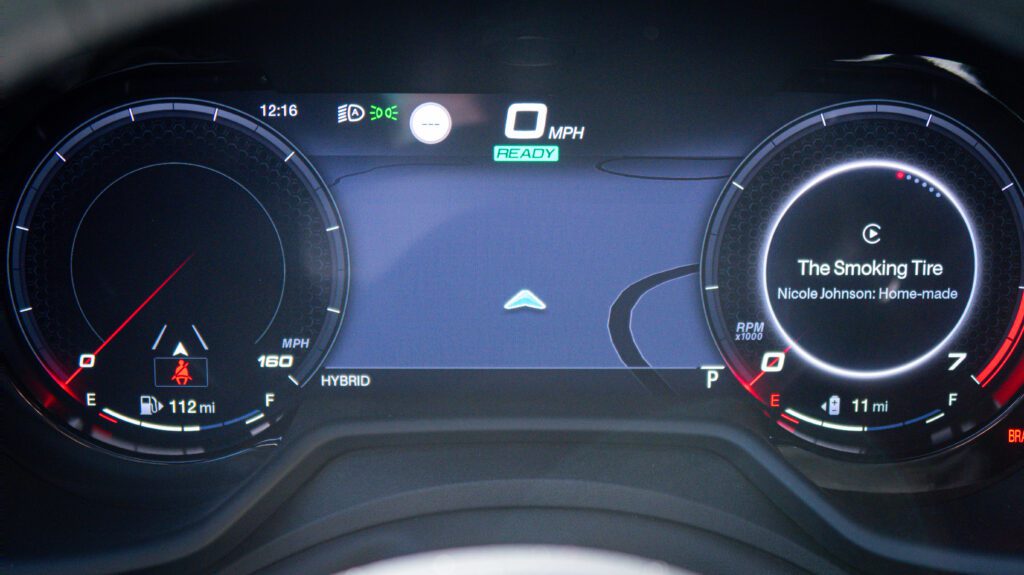
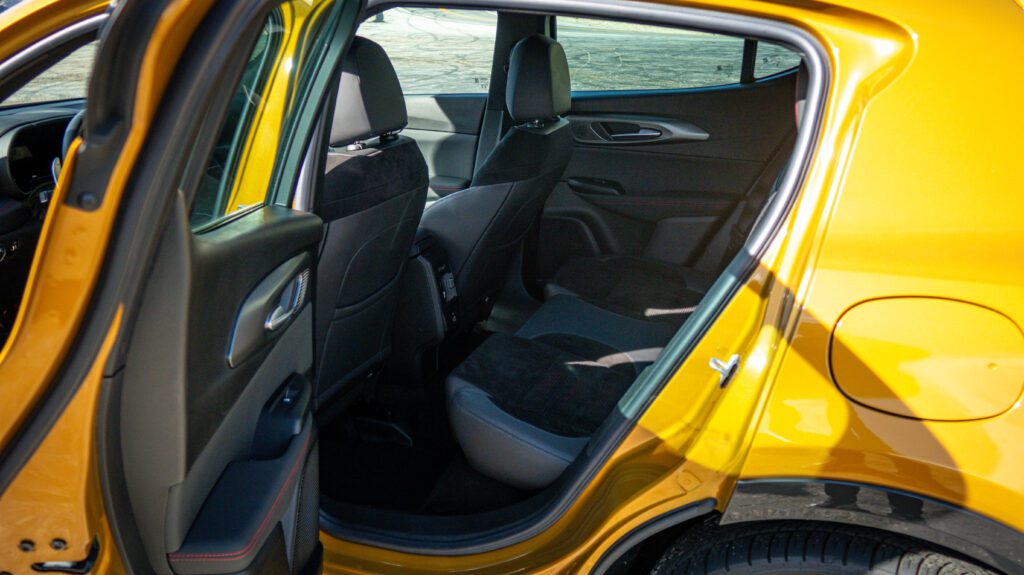
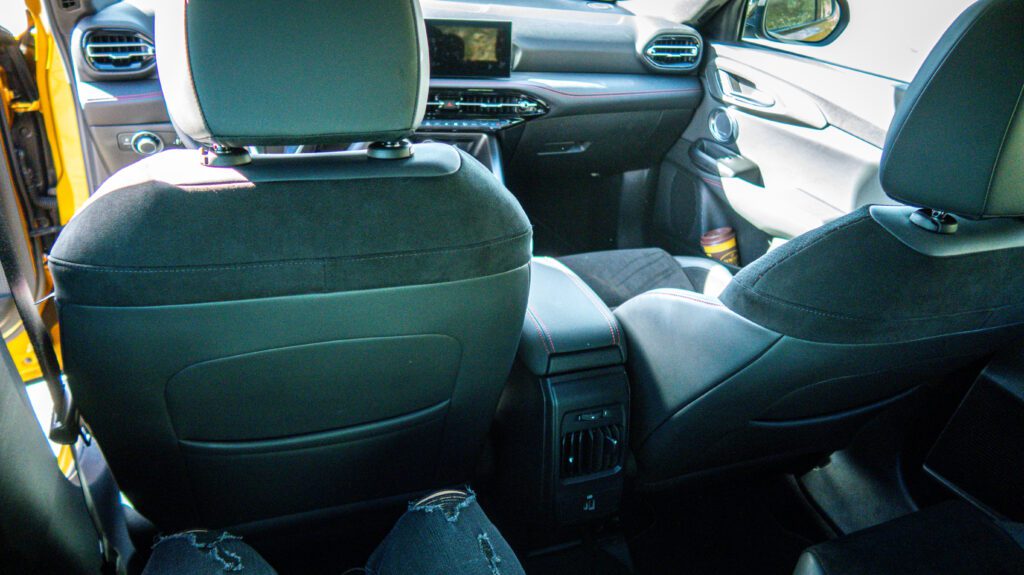

Most impressive was the commendable EV range afforded by the Hornet’s wee battery pack. An EPA rating of 32 miles places it near the upper echelon of plug-ins alongside other strong contenders such as the Alfa Romeo Tonale (33 miles), Ford Escape Plug-In (37 miles), and the Kia Niro Plug-In (33 miles). During my stint bouncing back and forth between Glendale and Redondo Beach, I found that best-case range to be easily believable, consistently getting 30 to 31 miles of EV range. The eSave and Sport modes prioritize gas operation to preserve and even assist with battery charge once you’re low on electrons, but oftentimes, the Hornet will always find that extra ounce in its cells for the occasional power boost off the line or on the freeway.
What’s less impressive is the total range, which could only ever be roughly 360 miles, including Electric mode. After reading the specs, you know instantly the R/T works best as your lifted city runabout. Fear no parking garage or tight back alley in the Hornet. But possibly fear interstate expeditions, as you have more frugal options. Ho-hum fuel economy in gas-only operation, further hurt by how the Hornet rarely operates as a “normal hybrid” like Toyotas, and a small fuel tank (a little over 11 gallons) means fill-ups are cheap but more frequent than you’d like if your commute sees a lot of freeway miles.

Don’t get me wrong, an EPA combined rating of 29 mpg and my 29.2 mpg average, even factoring in some hard canyon runs, aren’t bad at all! But a RAV4 Prime gets 38 combined, and its Ford Escape equivalent gets 40. What a shame this only functions as a normal hybrid a fraction of the time, heavily prioritizing gas-only or electric-only, even in Hybrid mode, because the Hornet saw mileage figures of 40 to 42 mpg in my hands when it does. Fail. Once more, at least fill-ups will be cheap.

Questionable hybrid operation paired with wonky lane-centering programming that struggles with cornering and a service warning that randomly appeared a thousand miles premature and never went away without tricking it with a specific start-up sequence makes for a crossover SUV that’s tough to recommend to the average consumer. Like seriously, this tech has been around for many years, yet it feels like an early adoption here.
I’ll write them off as hiccups in this early-build Hornet specifically, but still. Oh, Italy. Why are you like this? Oh, I can take a guess why. You must have had your priorities elsewhere, such as trying to turn the Hornet into…
A different breed of hot hatch
Gotcha, suckers! You thought this was a family car? Shut up and get to the pits. Monza beckons for a new champion.
Should anyone dare to take the R/T badge a little seriously and head for the hills with Sport mode engaged, the Hornet will oblige with the best driving experience a car of its size and class could possibly deliver. Make sure you sprung for the Track Package before you do. Trust.
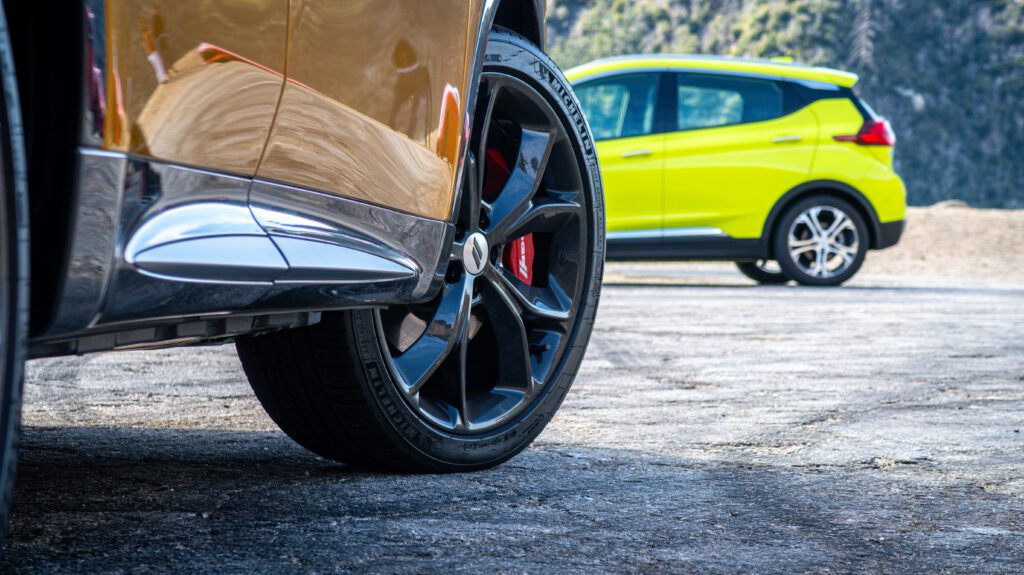
The 235-wide Michelin Pilot Sport All Season 4 tires are a godsend. They were great on a base C8 Corvette Gabe and I had previously sampled. They’re stellar here, enabling enough grip that you feel like you’re going to grip roll this golden egg down the hill, but thankfully, the KONI shocks do a commendable job at keeping body motions in check. They reportedly firm up in Sport mode. Frankly, the difference, if any, is negligible and still comfy enough for daily duty. You feel the body tilt in corners, but it takes a set and rotates right around with assistance from the torque-vectoring electric motors, almost never getting upset by mid-corner bumps and undulations despite the thin tire sidewalls and short wheelbase.

Steering was expectedly a tad numb and light, but there was just an ounce of feedback coming through to let you know there was a bump or the road surface had changed. A little more weight could do nicely, but at least it was reasonably quick and accurate for what’s ultimately still a family car. You can tackle most right-hand city streets and tight canyon bends without ever crossing arms, which is always nice.
Brakes? Effective. But a little wooden-feeling, needing a heavy foot to haul it down from the lofty speeds the plug-in powertrain is capable of. Which, by the way…
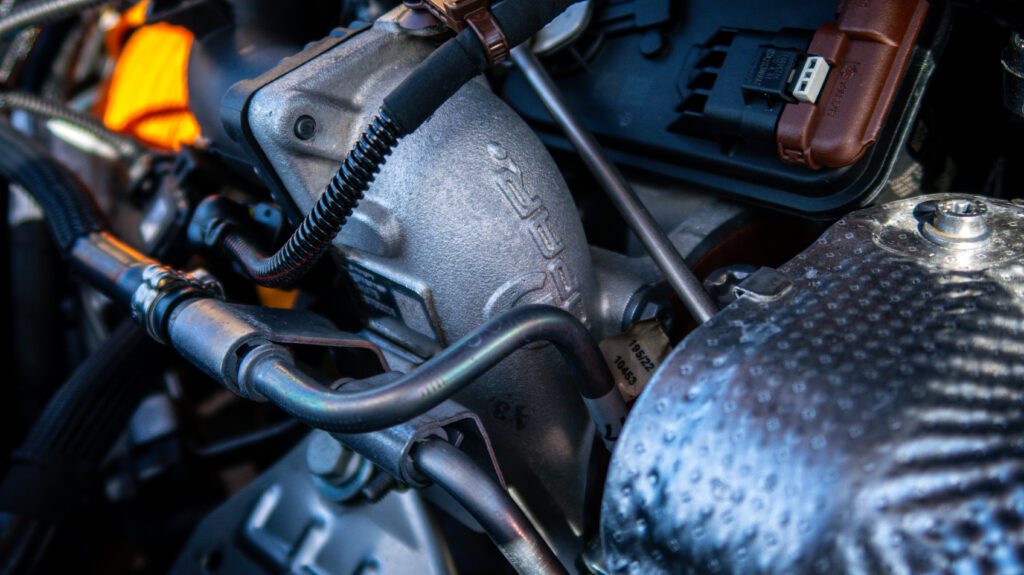
Did I mention this thing was fast? Because it’s fast. Quite fast. The big kid magazines have consistently clocked sprints to 60 mph around five and a half seconds, mirroring some V6 and turbo-four pony cars and posing a serious threat to GR86s and Miatas everywhere. The 1.3-liter pushing damn-near 30 pounds of boost out of its itsy-bitsy turbo must surely lag like a Group B rally car, but thankfully, its hybrid half fills in the torque more than adequately enough. Engage PowerShot mode, and you get 15 seconds of electric overboost with an extra 30 horsepower. Because that’s just what I needed on the way to Trader Joe’s. Whether that 30 horsepower is on top of the 288 or if the 288 is with PowerShot is unclear. But quick is quick.




Best of all, Sport mode’s battery regen, whether from the brakes or the engine itself, is far more aggressive than in eSave. Basically, whenever you’re not asking for juice for full-throttle sprints, it’s juicing the battery instead. This effectively means you can enter your local canyon road with a near-dead battery and come out with it nearly fully charged!
No charger? No problem. Just run for the hills (or your nearby freeway on-ramp).
As for the six-speed auto, it’s definitely no ZF or DSG. But it gets the job done and is thankfully responsive-ish to the familiar Alfa Romeo metal shift paddles. Sure, there were a few slight, quarter-second delays on a few upshifts. But its relative lack of sporting intent is forgiven when the paddles are this damn fun to click-clack around, just like its distant corporate cousins costing multiples more.
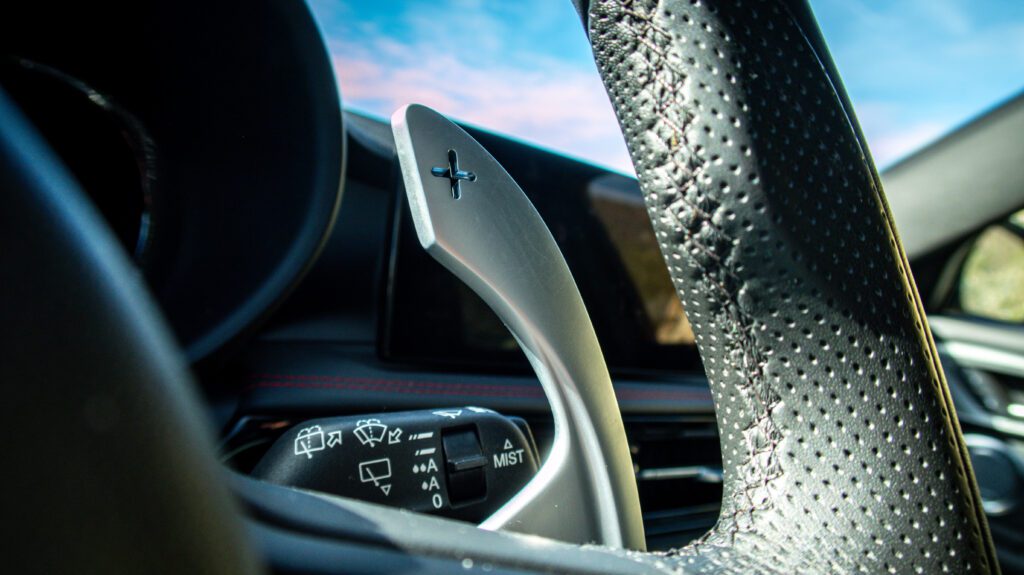
| What’s not? | – Unremarkable mpg in gas-only mode plus small gas tank equals short range – Rarely functions as a normal hybrid – Brakes require a heavy foot for performance driving or emergency stops – Somewhat small cargo area – Italian electronic annoyances – The Hornet GT and Alfa Romeo Tonale exist |
[Button id=”418″]
Too lovable but too flawed
Could you tell I’m smitten? It’s got style! It’s got swagger! It’s got speed, handling, and real-world urban commuting chops! After only five days, I fell in love with the Hornet R/T. I just don’t know if I can ever recommend a Hornet R/T. Here’s why.
If you insist upon a plug-in for the handy all-electric capabilities, the Tonale exists. For a few grand more than the comparable R/T, you can nab the actual donor car that’s arguably far more attractive and, frankly, more authentic because it’s the original one. The performance, despite being down on torque, is nearly identical. And according to a former engineer behind the project, it’s quieter and more refined.

Back in Detroit, there’s the Hornet GT, which trades its plug-in powertrain for an all-ICE 2.0-liter powertrain with comparable performance, fuel economy, and total range for $10,000 less. A Hornet R/T could buy you one comparable GT without the worry of charging and with leftover dough for a decent Fiat 500e if that’s your jam. Both corporate cousins leave the R/T in an odd spot between, “You got to really want it,” and, “I could use that spare couple thousand bucks.”
But looking at the R/T for what it is. If you don’t mind drinking Dodge’s Kool-Aid and partaking in the Americanized Italian hybrid for all it gets right, and in spite of all it gets wrong, then be my guest. And for most urban commutes, it’ll be more than enough. You may never even feel the crunch of its comparatively unremarkable range if you never leave the asphalt grid. It’s just roomy enough for friends and their shopping if they’re not big spenders, and you have all the ground clearance and agility in the world to dart between lanes and around parking lots in total, all-electric comfort. And if you want to show them a party trick on the way to your favorite downtown bar, Sport mode and PowerShot ought to do the trick.
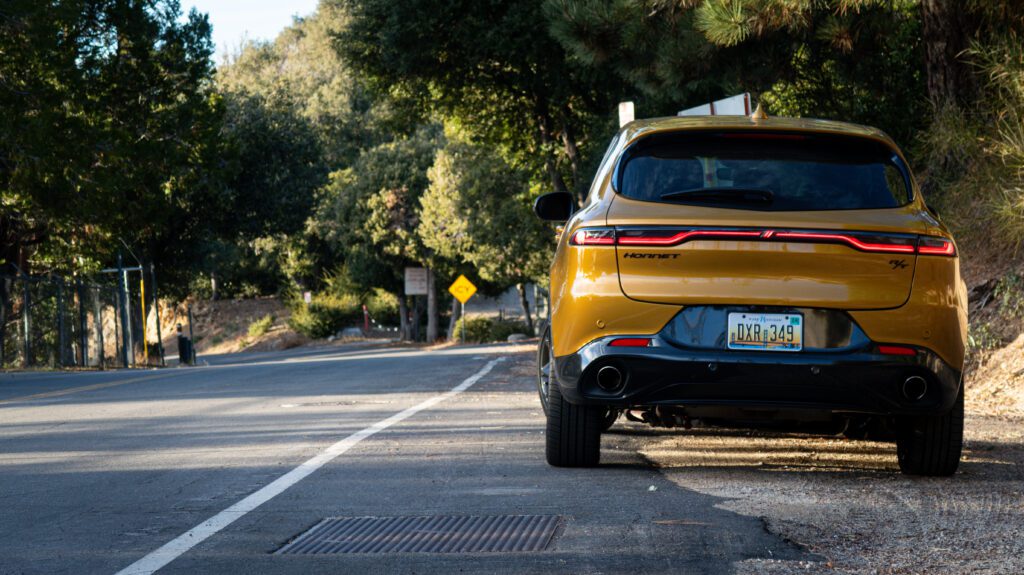
It’s hard to look at the Hornet R/T without seeing the sheer scope of its market and all with whom it competes. But on its own, it’s a rambunctious little RAV4 alternative with more charm and driving enjoyment than that cookie-cutter crossover will ever have. Hey. At the very least, I’m glad it exists.

